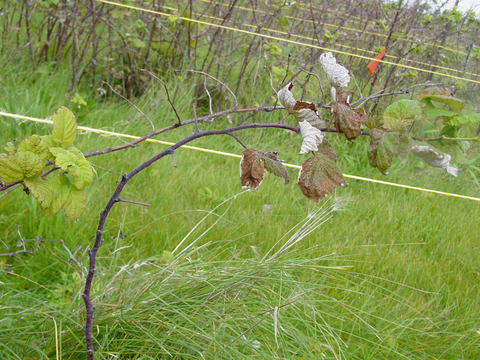Quick facts
- Raspberry leaf spot is common and very damaging in certain raspberry varieties.
- Leaf spots form on young leaves. Severely infected leaves fall off.
- During humid summers, primocanes (first year canes) can lose up to 75% of their leaves causing the canes to stop growing.
- These small canes produce less fruit and are likely to be damaged by winter injury.
- To manage this disease, plant on a site with full sun and good air circulation. Plant in narrow rows, remove weeds, and thin plantings that have become overgrown.
- In some varieties, the disease becomes worse each year unless it’s managed by cultural practices or fungicides.
How to identify leaf spot
Leaf spot Small dark green to black spots appear on the upper surface of young leaves.
- As leaves age, leaf spots turn white to gray. The center of the spot may fall out, leaving small holes in the leaf.
- Badly infected leaves curl downward at the edges and fall off.
- Small brown spots sometimes form on canes close to the ground.
How does leaf spot survive and spread?
- The fungus that causes leaf spot, Sphaerulina rubi, overwinters in infected leaf debris and in spots on canes.
- Only young, growing leaves and canes can be infected.
- Spores are spread by splashing water.
- Leaf spot is common in years when it rains often.
- The disease continues to spread all summer, as long as young leaves are present.
- Leaf spot causes the most damage in summers with heavy rains in June and July.
How to manage leaf spot
First decide if the diseased leaves are on primocanes (first year canes) or floricanes (second year canes). Leaf spot is more serious if it’s on primocanes. The leaves on floricanes naturally die towards the end of harvest.
Plant resistant varieties
Choose varieties that won’t be infected:
- The summer-bearing red varieties Latham and Nova are resistant to raspberry leaf spot.
Avoid varieties that are likely to be infected:
- The summer-bearing red varieties Boyne and Killarney are likely to be infected and can lose all of their leaves in years with frequent rain.
- Royalty, a purple variety (a cross between red and black raspberry species), is very likely to be infected. If your patch has leaf spot, don’t plant Royalty because the canes will become weaker each year as the leaf spot becomes worse.
Provide good air circulation
You can lessen leaf spot by using these cultural practices that help the leaves dry out after rainfalls:
- Maintain narrow raspberry rows at 18 inches wide or less.
- Thin primocanes during the first summer.
Prune out floricanes after harvest
- Remove floricanes after harvest to reduce the amount of fungus that overwinters in the patch.
- Canes should be buried or composted.
Fungicides
Fungicides are usually not necessary if you follow the good cultural practices listed above.
- In patches with a history of severe leave spot, fungicides can slow the spread of the disease.
- Sprays should be directed towards the recently sprouted canes.
- Sprays need to be applied according to label instructions and repeated throughout the season as long as new leaves and shoots are developing.
- Fungicides with the active ingredient copper, captan or myclobutanil can help prevent leaf spot.
CAUTION: Mention of a pesticide or use of a pesticide label is for educational purposes only. Always follow the pesticide label directions attached to the pesticide container you are using. Be sure that the plant you wish to treat is listed on the label of the pesticide you intend to use. And observe the number of days between pesticide application and when you can harvest your crop. Remember, the label is the law.
Reviewed in 2024


